AFC Interviews at Lille’s "Series Mania" Festival
Seamus McGarvey, BSC, ISC, ASC, and Joe Wright talk about filming the "M" series
"Humanising the evil", by François Reumont for the AFCBased on the eponymous novel, "M. Son of the Century" tells the history of a country that surrendered to dictatorship, and the story of a man who was able to rise from his ashes time and again – The Duce, Benito Mussolini. This eight-part series from Director Joe Wright covers the period from the founding of Fasci Italiani in 1919 through to Mussolini’s infamous speech in parliament following the murder of socialist Giacomo Matteotti in 1925.
- Joe Wright, director :
Why did you decide to take on this project ?
Joe Wright : Probably because my father, who was born in 1906, lived his life during this period. Personally, as a politically engaged leftist teenager, I remember calling any figure of authority—from my classroom teacher to the police—“fascist” without truly understanding what the word meant at the time. And now, since 2016 and Trump’s first election, we are suddenly confronted with this term again, which has only grown more prevalent in the news. So, it felt really important for me to ask the question—what is fascism, at its core ?—and to attempt to define it through the film. My guess is that it is a political transposition of toxic masculinity. This idea fascinated me and guided me throughout the project, much like the theme of self doubt shaped Darkest Hour and Winston Churchill’s portrayal. So, "M" can be watched as a historical portrait of Mussolini, but also as a deeper exploration of this theme in the background.

The recurring direct addresses to the camera by Mussolini are obviously the signature for this show…
JW : This was something we discussed extensively in preparation. My initial idea was to create a direct connection between Mussolini and the audience. And I mean everyone—not just older viewers or left-wing individuals who are generally more familiar with fascism... But also younger audiences who may not know much about this and may watch more series than features.
I wanted them to, in some way, feel seduced... to momentarily empathize with Mussolini. Because I believe the best way to make people question themselves is to suddenly pull the rug out from under their feet. To make them realize that, for a moment, their critical distance may have vanished. Mussolini, after all, charmed far beyond Italy.
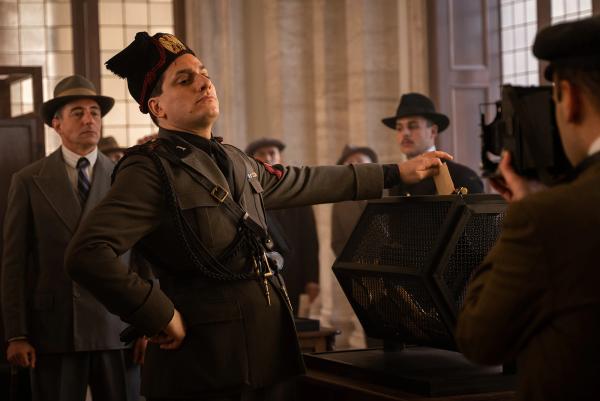
Even Winston Churchill, before the war, praised the "Roman genius" of Il Duce. Many world leaders in the late 20’s saw him as the best defense against the communist threat.
The communists were viewed as the villains, and in contrast, the fascists were conveniently placed in the "good guys" category. That’s exactly what happens when you demonize evil—it relieves people of any responsibility. Look at George W. Bush’s speeches on television about the atrocities committed at Abu Ghraib prison. He claimed the detainees embodied absolute evil, deep in their souls—a way to absolve his administration, his military, and his country from any responsibility for the acts of torture and abuse. I believe we must do the opposite. We must acknowledge our own dark side, our inner Mussolini. Because it exists, without a doubt.
The series also presents a very gothic vision of Italy…
JW : I didn’t feel that black and white was appropriate for this project. But one word kept coming to mind when thinking about the artistic direction : dirty.
I have always been a huge fan of Kieslowski’s A Short Film About Killing (1988), and I wanted to recreate that grimy feeling they achieved. I researched how cinematographer Slawomir Idziak shot it and learned that many scenes were filmed through taylor made neutral density filters, with various shapes. Seamus McGarvey told me we could do something similar using black candle smoked neutral filters on the go. This technique not only added a slightly monochromatic quality to the image—without leaning towards yellow, a color I don’t particularly like—but also contributed to the unsettling atmosphere we were aiming for. The combination of this visual dirtiness with tilted, or skew style framing inspired by the Futurist movement of the 1920s and Dziga Vertov’s Man with a Movie Camera. I hope it helps create the necessary discomfort for the film.
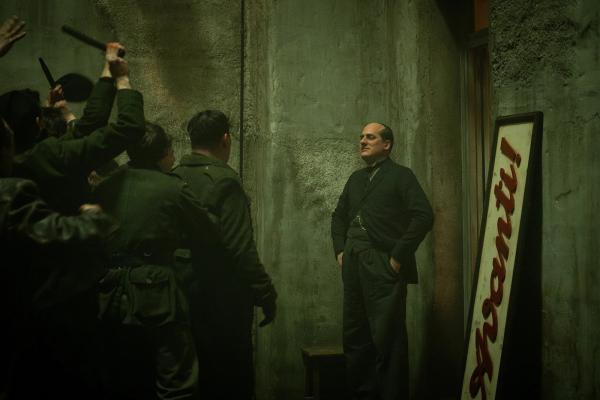
- Seamus McGarvey, cinematographer :
Joe Wright describe the Mussolini adresses to the camera as a way to connect with audience...
Seamus McGarvey : I really saw it as a way to grab the viewer by the throat. To force them, in a way, to listen to Mussolini’s rhetoric. I think we didn’t want them to take refuge behind the usual cinematic grammar—and in a way to shatter it with this unusual form.
Actually, I remember a moment when Mussolini’s monologues were to be perfomed in English by Luca... while the rest of the series remained in Italian. So to reinforce again the universal power of his words.
But this choice would have distanced the project from Italy itself. Given the current political climate, Joe and the producers ultimately decided against it so that every Italian could fully embrace the film. Paradoxically, the presence of subtitles ended up enhancing this effect—text further emphasized the propaganda aspect, intensifying the feeling of being held captive by Mussolini’s rhetoric.
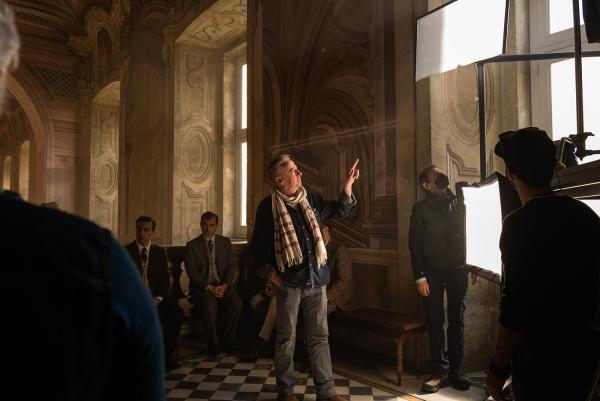
But talking to the camera can be much often considered as a comic form in movies, can’t it ?
SM : At first, I confess a few worries... That people might think of Ricky Gervais’s "The Office" for example... But thankfully, the superb writing and Luca Marinelli’s chilling performance ensured a completely different tone.
Indeed there is nothing objectively funny about this serie, though some of the sycophantic characters surrounding Mussolini do tap into certain comedic tropes. This often happens when despotic figures rise to power—they tend to be surrounded by ridiculous individual, idiot savants who serve as their foils. It’s one of the secrets of authoritarianism and leads them to making grand promises while lying shamelessly
Anyway, for those scenes where Mussolini addresses the audience, Joe and I decided to always use the same lens to give these moments a distinct texture. The Canon RF 50mm f/0.95 "Dream Lens", originally designed for 1970s rangefinder cameras was our speech lens.
By shooting at wide open, the effect is truly unique—there’s almost no depth of field. When Luca looks into the camera, his eyes are the only thing in focus, while everything else melts into a strange, surreal blur.
Joe is also evoking the use of candle smoked filters on the show...
SM : Yes, that was a very interresting thing to do... Filming through those allowed us to create a vignette effect around the edges of the frame in a very organic way. It’s very different from adding this effect in post-production. It’s also riskier because you can’t go back and adjust it later... But one surprising discovery during testing was that this method not only darkens and tints parts of the image—it also slightly diffuses the light, so the center is very sharp and the edges s bit blurry and darker. This was something we found quite difficult to replicate in digital color grading.
Looking at the final result, I realize that the image of this series almost feels stained by nicotine, like an ashtray left for years with cigarettes ending on it.

How long did you shoot ?
SM : Like all TV series, time was limited. The budget per minute of content is nowhere near that of a feature film. Luckily, Joe is extremely precise—he prepares everything meticulously, with extensive shot lists. While minor adjustments happen, each scene is anchored in solid planning.
Besides, the script was so full of dialogue that we couldn’t afford to do too many takes or extensive coverage. We worked with a fairly small crew, built around our usual collaborators. I’m thinking in particular about Peter Robertson, our camera operator, with whom we’ve already made six or seven films. In the end, working quickly in these conditions was actually quite enjoyable, especially within the context of such an incredibly long shoot—20 days per episode, totaling 160 days of filming. In fact, it was the longest shoot we had ever undertaken together.
Given the long dialogues and the time constraints of film reloading, we opted for digital from the start. However, for sequences designed to look like historical black-and-white footage, I used an hybrid approach.
We shot these scenes digitally (using the Alexa 35) but later had them refshot onto 16mm film using a simple camera placed in front of a monitor playing our footage. The film was then processed in a home bathtub, complete with scratches, dust, and imperfections.
When scanned back into digital, these shots suddenly looked genuinely archival—without relying on heavy post-production tricks.
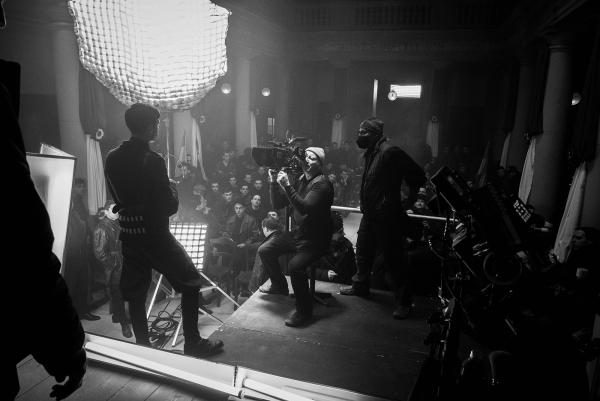
What about lighting ?
SM : As I was saying, Joe puts a tremendous amount of preparation into each film, creating mood boards, conducting visual research, and sending me numerous references. For "M", I particularly remember sketches—pencil drawings by artists from the 1920s. Very minimalist, highly graphic pieces. We also discussed cinema from that period, such as Dziga Vertov’s films, which were influenced by the Futurist movement... born in Italy at the beginning of the century.
This inspired the high-contrast lighting approach I often used, with strong, directional beams of light. I incorporated smoke as well, like in that nighttime exterior scene in Episode 1, when Mussolini leaves Cesarino in the street after shouting he’s going to "make war on the world."
I really enjoy these kinds of situations, where the characters are almost treated as silhouettes, with the focus on lighting the smoke behind them rather than directly illuminating the subjects. This is also where an ultra-sensitive camera like the Alexa 35 is truly a pleasure to work with.
I could then rely on a large softbox equipped with SkyPanel S60s as the main light source—easily controllable via a console, allowing me to precisely adjust the exact color I wanted in real time.
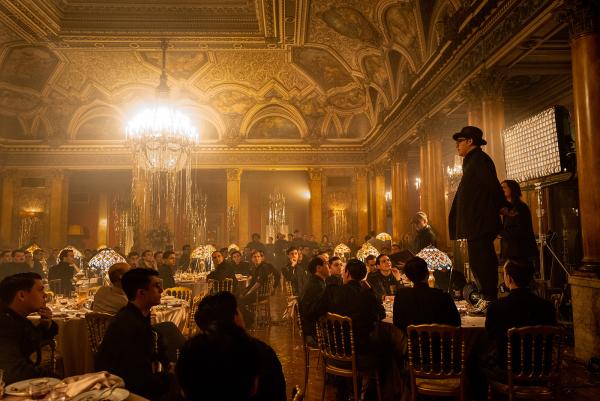
What did you learn about this series, now that you live in Italy...?
SM : Yes, indeed I have been living in Tuscany for a few years now... But my mastery of Italian is not yet perfect ! And I must say that working on an Italian series made me see things differently. As you don’t fully understand the dialogues, you engage with the film’s visual approach in a different way. It’s an opportunity to break free from your habits, your preconceptions, and focus in a completely new way on what is happening in front of the camera.
Paradoxically, as a director of photography, your vision shifts more toward choreography and the meaning of each frame—without the words might add. I think this experience pushed me toward a more experimental and, ultimately, daring visual style compared to other films I’ve worked on. From that perspective, it was a very rewarding experience.
In one of our previous discussion, you mentioned using artificial intelligence for a particular sequence...
SM : Indeed. There is a fairly brief orgy sequence in the series where Joe wanted a top-shot movement over 300 naked people engaging with each other. Given the complexity of this shot, Sophie Muller, the second-unit director, suggested generating something using a text-to-video engine.
By using keywords like "orgy, 1920s, black and white, overhead camera movement from left to right," we were able to generate a shot. To my great surprise, the AI-generated result was quite convincing—at least enough to make it into the final edit of the series.
But what truly unsettled me was that many graphical elements in the shot seemed to be directly inspired by a black-and-white music video I had shot for the Pet Shop Boys about twenty years ago. The song was called "You Only Say You Love Me When You’re Drunk", and when you compare the two, the similarities are obvious—especially in the way the bodies blend together with the movement.
I must admit that I’ve already used AI-generated images quite a bit in pre-production for some projects... But this is actually the first time I found myself directly confronted with this kind of direct image steal !
(Interviews by François Reumont for the AFC)
 En
En Fr
Fr





